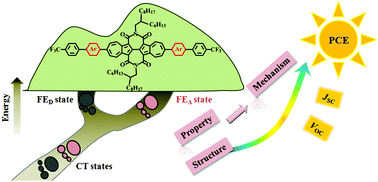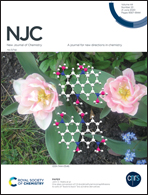Can we utilize the higher Frenkel exciton state in biazulene diimides-based non-fullerene acceptors to promote charge separation at the donor/acceptor interface?†
Abstract
A hot exciton model is a widely accepted mechanism for the generation of photocurrent in organic bulk-heterojunction solar cells, in which the charge is transferred from the high-energy Frenkel exciton state (FE state) of the donor to the low-energy charge transfer states (CT states) and then is further separated into free charges. However, the FE state energy of the acceptor (FEA state) is usually lower than the values of CT states, which could hinder the pathway of efficient charge transfer from the FEA state to CT states. In order to take full advantage of this pathway, in this study, acceptor molecule 1 which breaks the Kasha's rule was selected to constitute the donor/acceptor (D/A) interface with donor molecule PTB7-Th. The density functional theory (DFT) and the time-dependent density functional theory (TD-DFT) calculations focusing on the charge transfer mechanism were carried out to verify our supposition. The results indeed show higher energy in the FEA state than the lowest CT states and enhanced charge transfer contribution (about 90%), which implies the realization of this additional pathway. Meanwhile, based on acceptor molecule 1, molecules 2–6 were designed by introducing different functional groups with the aim of enhancing the open circuit voltage (VOC) and photo-absorption ability while maintaining the advantage of the higher FE state energy, which demonstrates the improvement in hole and electron generation efficiency to some extent. Therefore, this study may provide a good strategy for designing new non-fullerene acceptors for organic solar cells (OSCs).



 Please wait while we load your content...
Please wait while we load your content...